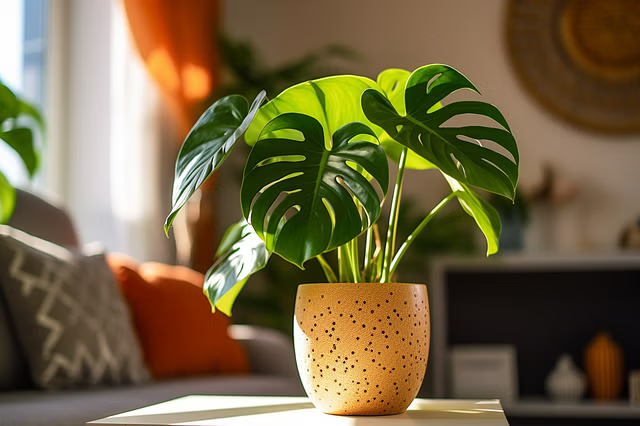If you’ve ever scrolled through Instagram plant posts or browsed home décor magazines, chances are you’ve seen a Monstera plant. Known for its iconic, split-leaf appearance and lush, tropical vibes, this trendy houseplant has captured the hearts of plant lovers worldwide. The good news? Monstera plants are surprisingly easy to care for, even for beginners.
In this detailed guide, we’ll walk you through everything you need to know about Monstera plant care — from choosing the right spot to watering, fertilizing, and troubleshooting common problems. Whether you’ve just brought home your first Monstera or you’re considering adding one to your collection, this guide will help you keep your plant healthy and thriving.

What is a Monstera Plant?
The Monstera deliciosa, often called the Swiss Cheese Plant, is a tropical climbing plant native to the rainforests of Central America. Its large, glossy green leaves develop unique natural holes and splits called fenestrations, making it one of the most striking and recognizable houseplants.
Monsteras are prized for their fast growth, air-purifying qualities, and bold, architectural look, making them an ideal choice for modern interiors and plant enthusiasts.

Choosing the Right Spot
Light is crucial for Monstera care. These plants naturally grow beneath the rainforest canopy, so they prefer bright, indirect light.
Ideal lighting conditions:
- Bright, filtered light near a window with sheer curtains
- East or west-facing windows with morning or late afternoon sun
- Can tolerate lower light but will grow slower and produce fewer leaf splits
Avoid:
- Direct, intense sunlight, which can scorch the leaves
- Complete shade or dark corners, which lead to leggy growth
If your space lacks natural light, consider using a grow light for 8-10 hours a day.

How to Water a Monstera
Getting the watering right is key to a happy Monstera. These plants prefer soil that stays moist but not soggy.
Watering guidelines:
- Water when the top 2-3 inches of soil feel dry to the touch
- In warmer months (spring and summer), this could be once a week
- In cooler months (fall and winter), reduce to every 10-14 days
Pro Tip:
Use room-temperature, filtered, or dechlorinated water for the healthiest growth. Always empty the saucer after watering to prevent root rot.
Signs of overwatering:
- Yellowing leaves
- Mushy stems
- Foul-smelling soil
Signs of underwatering:
- Drooping leaves
- Dry, brittle edges

Choosing the Right Soil
Monsteras love a well-draining, chunky potting mix that mimics their natural tropical environment.
Recommended soil mix:
- 2 parts peat-based potting mix
- 1 part perlite for drainage
- 1 part orchid bark or coarse coco chips for aeration
You can also purchase a pre-mixed aroid potting mix made specifically for Monsteras and other tropical plants.
Pot and Repotting
Monsteras grow quickly and will need repotting every 1-2 years to prevent becoming root-bound.
Potting tips:
- Choose a pot with drainage holes
- Repot when roots start growing out of the drainage holes or the plant looks overcrowded
- Size up the pot by 1-2 inches in diameter each time
Repotting is best done in spring or early summer, when the plant is actively growing.
Humidity and Temperature
As a tropical plant, Monsteras thrive in warm, humid conditions.
Ideal environment:
- Temperature: 65°F to 85°F (18°C to 29°C)
- Humidity: 50% to 80%
If your indoor air is dry, especially in winter, increase humidity by:
- Using a humidifier
- Placing the pot on a tray with pebbles and water
- Grouping plants together
Avoid: Cold drafts, sudden temperature changes, and placing near heating vents.
Fertilizing Your Monstera
For lush, vigorous growth, Monsteras benefit from regular feeding during their growing season.
Fertilizer recommendations:
- Use a balanced, water-soluble fertilizer (like a 20-20-20)
- Apply once a month in spring and summer
- Reduce to every 6-8 weeks in fall and winter
Alternatively, use an organic houseplant fertilizer or diluted fish emulsion for a natural option.
Training and Pruning
Monsteras are natural climbers and appreciate some support as they grow.
Training:
- Install a moss pole, trellis, or bamboo stake
- Secure stems loosely with plant ties as they grow
Pruning:
- Trim dead or yellowing leaves regularly
- Prune overgrown stems in spring to control size and shape
- Use sharp, clean scissors to prevent disease
Pruning can also encourage bushier, more compact growth.
Common Monstera Problems and Solutions
Even with the best care, your Monstera might occasionally show signs of stress. Here’s how to diagnose and fix common issues:
| Problem | Cause | Solution |
|---|---|---|
| Yellowing leaves | Overwatering | Check soil moisture, adjust watering |
| Brown, crispy leaf edges | Low humidity or underwatering | Increase humidity, water consistently |
| Drooping leaves | Over or underwatering, low light | Check watering habits, relocate |
| No fenestrations (holes) | Insufficient light, young plant | Move to brighter spot, be patient |
Propagating a Monstera
Want more Monsteras for free? It’s easy to propagate them using stem cuttings.
How to propagate:
- Cut a stem below a node (a small bump on the stem) with at least one leaf attached
- Place the cutting in water or moist soil
- Keep in a warm, bright location (no direct sunlight)
- Change water every few days if rooting in water
- After roots develop (2-4 weeks), transfer to potting soil
Propagation is a fun and beginner-friendly way to multiply your plant collection or share with friends.
Final Thoughts
Caring for a Monstera plant as a beginner is both rewarding and straightforward. By providing the right balance of light, water, humidity, and soil conditions, you’ll enjoy watching your Swiss Cheese Plant flourish with those iconic, split leaves.
As you grow more confident, you might even try propagating your plant or training it to climb a moss pole. Either way, your Monstera will become a stunning, green focal point in your home while improving your indoor air quality and creating a refreshing, tropical ambiance.
So, bring home a Monstera and watch your plant-parenting skills bloom!





Leave A Comment